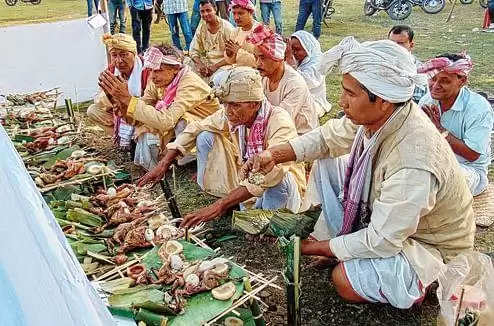Me-Dam-Me-Phi : Trace the mind blowing history of this century old practice of Assamese communities!

The ancestor worship among the Ahoms is called Me-Dam-Me-Phi which is celebrated on January 31 every year. Literally, 'Me' means worship, 'Dam' means the dead, and 'Phi' means God. That is, the dead ones are worshipped as gods by the Ahoms. The families pray at a Cheng-Ren (Ahom community's Naamghar / Prayer Hall) so that the deceased is elevated to the position of 'Phi' or god.
This belief in the divinity of the dead is an ancient one and it is said that all the Tai (Thai)-speaking people have had the custom of worshiping the ancestors as gods in their own way.

According to the Tai Ahom belief, man is not reborn after death. One of the important customs among them is that the dead body is not burnt but kept in a box. This is called ''Maidam''.
It is also written in history that Chaolung Siu-ka-pha, the first Swargadeo (heavenly king) of the Tai Ahoms observed this sacred ritual of Me-Dam-Me-Phi and sought the blessings of his forefathers in the new palace. After his death, Chaolung Siu-ka-pha was buried in Charaideo and Me-Dam-Me-Phi was observed by his son who became the King after him. As all the kings and queens of the Tai Ahoms got buried in this sacred place, Chardideo became the "Jerusalem of the East" for all the Tai-speaking people and the designs and techniques of the Maidams have become a strong object of attraction and the subject of research for all inquisitive learners.
It so happened that during the reign of Jaydwaj Singha, the ritual was not observed. When Jaydwaj Singha was defeated by the Mughal Army led by Mirjumla, the King said to the Prime Minister, Atan Buragohain, in deep anguish and grief, "Gohain, gods have forsaken me." Gohain then said, "Swargadeo, do not grieve. Victory and defeat are two sides of the same coin. When gods will favour us, then Swargadeo will defeat the outsiders with his own might." The king believed that since this festival was not performed, he couldnt win over the enemies and had to accept defeat to the rising powers of the Mughal Army.
After his death, the younger brother Chakradwaj Singha could realize why the mighty Ahom King was defeated by the Mughals. He performed the worship won the Battle of Saraighat to re-establish the glory of the Ahoms.
There are three types of Me-Dam-Me-Phi: public festival (for the King, country and people); domestic festival(with five raised bamboo platforms for gods i.e. Maihang); and again a type of domestic festival (with three Maihangs). The gods and goddesses propitiated are: Khao Kham on the floor; Ai-Leng-Din, Lengdom, Lang Kuri and Jan Chai Hung on a raised platform; and Chit-Lam-Cham, Mut-Kum-Tai-Kum and Yachingpha, all normally. The holy book of the Ahoms, Pak-Pen-Kaka, is put on the on the place of worship.

In the traditional Ahom families, Dam-Puja is celebrated every year. The ancestors of the family are worshipped with great reverence.There is a household Dam-post or Phi-lang post in the kitchen of such families. Of course, without propitiation of the gods Lang-Kuri (the fifth guru), Janchaihong, Lareng and Lengdon, Dam-Puja of the family in the first month of Lakni-era (i.e Aghon) is not held. In this Dinching month of Lakni, three previous generations of the dead are worshipped. The concept of having a post for the worship of gods is not unusual in traditional societies. Among the hill Lalungs (Tiwa) such a post is kept in the kitchen and offerings are given there.
By the end of the thirteenth century almost all the Tai people got converted to Buddhism (of the lesser vehicle). But even after the conversion, the Tai people did not give up the practice. Khamti, Khameyang, Phake and Aitons offer flowers and rice to seek the blessings of their forefathers. Similarly, Lao, Shan, Thai of Laos, Myanmar, Thailand and Lu and Dais of South China observe the ritual even after becoming Buddhist.The Thais, who profess traditional religion and have remained non-Buddhist like Taidam, Taikhao, Nang, Nung of North Vietnam, also observe the ritual by offering meat and other eatables to the dead.
Me-Dam-Me-Phi is celebrated throughout Assam. However, you will find more celebration in the districts of Sivasagar, Dibrugarh and Lakhimpur on this day because of the adequate number of Ahoms in these areas.
- Compiled by Payal Bhattacharjee with inputs from internet sources.
Image courtesy : Internet sources

















